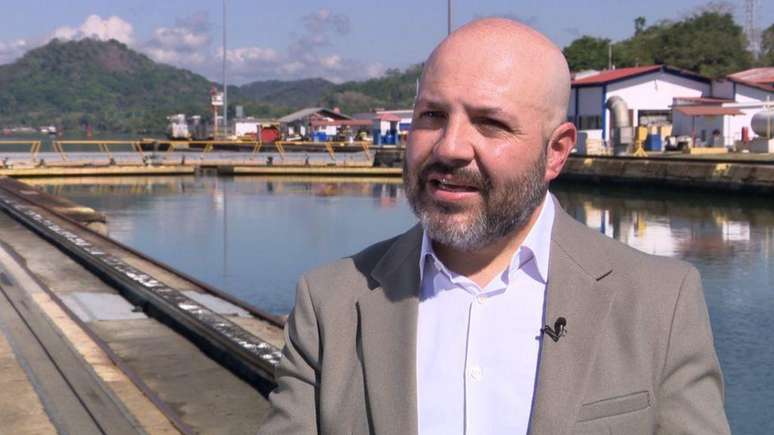Canal authorities are concerned about the situation and plan to invest $8.5 billion in sustainable projects over the next five years to try to improve the waterway’s situation.
America’s most famous waterway is drying up.
Unlike the Suez Canal, the Panama Canal is fed by a freshwater lake, Lake Gatún, and its water level is critically decreasing.
During a boat ride on the Gatún, Nelson Guerra, a hydrologist with the Panama Canal Authority, a Panamanian government agency, points to a rusted ruler under a tower at the western end of the water.
“The level, as seen on the ruler, is 81.20 feet,” he says. “It should be 1.5 meters higher than now.”
On the return trip, the boat passes old tree trunks protruding from the water. They were never completely demolished during the original construction of the lake. Only a few would be visible this time of year. But in the middle of the dry season there is a forest of it.
The Panama Canal depends on rainwater, which is scarce.
Lack of rain and the El Niño weather phenomenon contributed to the second driest year in the canal’s 110-year history.
Last October was the driest on record. It has rained 41% less than normal in the canal region, and the drought threatens to continue disrupting $270 billion worth of cargo that flows annually through the shortcut between the Atlantic and Pacific.
Water-saving measures have had to be taken in the region, meaning fewer ships can pass through the canal every day. This is because water from the lake is needed to operate the canal locks.
Effects on maritime trade
The number of ships has been reduced on average from 36 to 24. Additionally, each ship now carries less cargo due to weight restrictions.
The slowdown poses a problem for global trade.
In normal times, about 5% of global maritime trade and 40% of U.S. container traffic use the canal.
If the route dries up, carriers will be forced to look for alternatives, which will lengthen travel times and increase costs.
And water shortages aren’t just a global trade problem. The Panama Canal Authority also provides drinking water to half the country’s population, including residents of the capital, Panama City.
But the channel’s managers are taking steps to ensure its sustainability in the future.

Water saving plans
The Panama Canal Authority’s head of sustainability, Ilya Espino de Marotta, says they are working to find solutions to ensure the canal does not run out of water.
“We don’t want this to become a recurring problem. We don’t want traffic or weight limits to go down,” he tells the BBC.
It has focused on developing a plan to invest $8.5 billion in sustainable projects over the next five years and hopes it can help the waterway survive even as climate change shakes the planet.
Regarding these climate changes, Ilys Espino Marotta says: “Panama is a country where it rains a lot… but we see that a pattern (of precipitation reduction) is approaching that affects all parties. So we absolutely have to prepare for the future.”
One obvious measure is to save water.
The Panama Canal works by passing ships through a series of locks above sea level, fed by Lake Gatún and the smaller Lake Alajuela.
Each ship passing through the locks uses about 50 million gallons of water, and some new locks built in 2016 – the Neo-Panamax locks, the largest – save about 60% of that water.
However, the old Panamax locks remain in operation and renovating them would be a major project. But Marotta has found a way to reuse the water from the locks, called cross-filling, saving the equivalent of six crossings a day.
It is also considering building reservoirs, its first major project since the new set of locks was completed in 2016.
To save more water in the rainy months and increase supplies in drier periods, there are plans to build a dam on the nearby Indian River and transport the fresh water to Gatún Lake, the canal’s main reservoir. The plan would increase ship traffic by between 12 and 15 ships per day.
But it won’t be easy moving forward. The project does not yet have congressional approval and its construction will take several years to complete.
Another option is to build desalination plants. The lack of rain has increased the salinity of lakes and rivers, a challenge that must be carefully considered, as it is the country’s largest source of drinking water. But this option is expensive, and extracting salt from seawater requires a huge amount of energy.
Planting clouds in the hope of more rain is not out of the question. The process of implanting large particles of salt into clouds to increase precipitation seems futuristic, but it has been around since the 1940s.

There is no better shortcut
A solution must be found to improve the world trade scenario, which has become more unstable this year. Trade volumes through the Panama Canal are down 49% from their peak.
José Cervantes, general manager of the Panamanian branch of the Agunsa shipping company, says daily operations have been affected. Shipments of two million tons of goods, from textiles to food, have been delayed due to problems in the canal.
He says the difficulty is that there are no other good shortcuts.
Before the current Red Sea crisis, some ships carrying goods from Asia were diverted through the Suez Canal. With this less safe option, demand for rail and road transportation through Panama has increased.
But José Cervantes argues that unloading and reloading cargo from ships onto trains and trucks increases costs. “And these costs are generally passed on to the consumer,” he says.
If the rains arrive in May as expected, the canal plans to increase the number of ships that can pass through its locks, but this is only a short-term solution.
The changes in precipitation patterns serve as a reminder of the large impact climate change could have on global trade and the long-term future of the Panama Canal.
Source: Terra
Rose James is a Gossipify movie and series reviewer known for her in-depth analysis and unique perspective on the latest releases. With a background in film studies, she provides engaging and informative reviews, and keeps readers up to date with industry trends and emerging talents.






